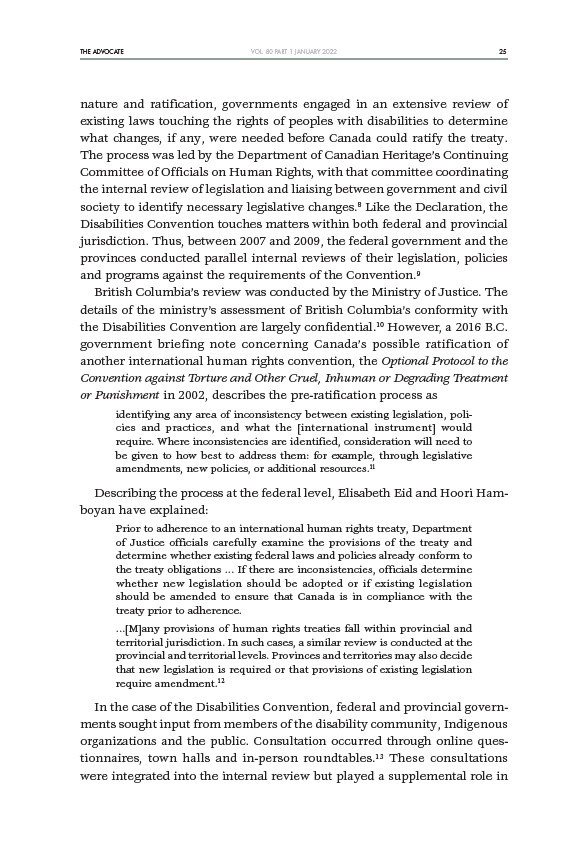
THE ADVOCATE 25
VOL. 80 PART 1 JANUARY 2022
nature and ratification, governments engaged in an extensive review of
existing laws touching the rights of peoples with disabilities to determine
what changes, if any, were needed before Canada could ratify the treaty.
The process was led by the Department of Canadian Heritage’s Continuing
Committee of Officials on Human Rights, with that committee coordinating
the internal review of legislation and liaising between government and civil
society to identify necessary legislative changes.8 Like the Declaration, the
Disabilities Convention touches matters within both federal and provincial
jurisdiction. Thus, between 2007 and 2009, the federal government and the
provinces conducted parallel internal reviews of their legislation, policies
and programs against the requirements of the Convention.9
British Columbia’s review was conducted by the Ministry of Justice. The
details of the ministry’s assessment of British Columbia’s conformity with
the Disabilities Convention are largely confidential.10 However, a 2016 B.C.
government briefing note concerning Canada’s possible ratification of
another international human rights convention, the Optional Protocol to the
Convention against Torture and Other Cruel, Inhuman or Degrading Treatment
or Punishment in 2002, describes the pre-ratification process as
identifying any area of inconsistency between existing legislation, policies
and practices, and what the international instrument would
require. Where inconsistencies are identified, consideration will need to
be given to how best to address them: for example, through legislative
amendments, new policies, or additional resources.11
Describing the process at the federal level, Elisabeth Eid and Hoori Hamboyan
have explained:
Prior to adherence to an international human rights treaty, Department
of Justice officials carefully examine the provisions of the treaty and
determine whether existing federal laws and policies already conform to
the treaty obligations … If there are inconsistencies, officials determine
whether new legislation should be adopted or if existing legislation
should be amended to ensure that Canada is in compliance with the
treaty prior to adherence.
…Many provisions of human rights treaties fall within provincial and
territorial jurisdiction. In such cases, a similar review is conducted at the
provincial and territorial levels. Provinces and territories may also decide
that new legislation is required or that provisions of existing legislation
require amendment.12
In the case of the Disabilities Convention, federal and provincial governments
sought input from members of the disability community, Indigenous
organizations and the public. Consultation occurred through online questionnaires,
town halls and in-person roundtables.13 These consultations
were integrated into the internal review but played a supplemental role in